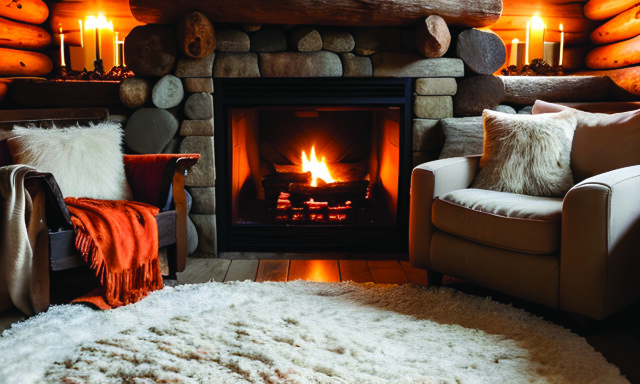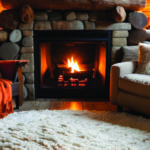When the cold weather sets in, nothing beats the comfort and warmth of a cozy fireplace. Traditional wood-burning fireplaces have long been a staple in homes during winter, but an increasing number of homeowners are turning to natural gas fireplaces. These modern alternatives offer numerous benefits, making them a top choice for those looking for convenience, efficiency, and style during the colder months.
In this article, we’ll explore the key advantages of using a natural gas fireplace in winter, focusing on how it can improve your home’s comfort, save you time and energy, and enhance your overall winter experience.
1. Convenience and Ease of Use
One of the biggest advantages of a natural gas fireplace is the ease of use. Unlike traditional wood-burning fireplaces, which require you to gather wood, build a fire, and constantly monitor it, a natural gas fireplace is as simple as flipping a switch or pressing a button. Many models come with a remote control or even a smartphone app, allowing you to adjust the flame height, heat output, and lighting without leaving your seat.
If you’re looking for a warm and inviting atmosphere without the hassle of tending to a wood fire, a natural gas fireplace is a clear winner.
2. Energy Efficiency and Cost Savings
Natural gas fireplaces are known for their energy efficiency. Gas burns cleaner and produces more heat than wood, meaning it can warm your home faster with less fuel. Many gas fireplaces also come with an adjustable thermostat that allows you to maintain a consistent temperature, which can help reduce overall heating costs.
If you’re wondering what is a good natural gas rate, it’s worth noting that natural gas is typically more affordable than electricity, making it a cost-effective heating option. In the long run, a natural gas fireplace could be a smart investment, helping you save on fuel while enjoying a consistent, controlled environment throughout the winter months.
3. Cleaner and Healthier Air
When you burn wood in a traditional fireplace, it releases smoke, ash, and other particulate matter into the air. Not only can this be a nuisance, but it can also affect the air quality in your home. In contrast, natural gas is a cleaner burning fuel. It produces significantly fewer pollutants, including no soot, ash, or smoke, which means your indoor air quality remains much healthier.
This is especially beneficial for families with children, elderly members, or individuals with respiratory issues such as asthma or allergies. With a natural gas fireplace, you can enjoy warmth without compromising air quality.
4. Environmental Friendliness
Natural gas is considered a greener alternative to other fuels like coal or oil. While it is a fossil fuel, it emits fewer greenhouse gases when burned compared to other traditional heating methods. Natural gas fireplaces produce fewer carbon emissions, making them a more environmentally friendly option for heating your home.
If you’re looking to reduce your home’s carbon footprint during the winter months, choosing a natural gas fireplace is a step in the right direction.
5. Aesthetic Appeal and Design Flexibility
Modern natural gas fireplaces come in a variety of styles and designs, allowing you to choose one that complements your home’s decor. Whether you prefer a sleek, contemporary look or a more traditional, rustic aesthetic, there’s a gas fireplace to fit your taste. Many models feature glass enclosures, decorative rocks, or even custom flame effects to enhance the visual appeal of your living space.
Additionally, because there’s no need for a chimney or venting system, a natural gas fireplace can be installed in more places throughout your home, including areas where traditional wood-burning fireplaces wouldn’t be feasible. This makes them a versatile option that can enhance the overall design of your space.
6. Safety and Reliability
Natural gas fireplaces are generally safer than their wood-burning counterparts. Wood-burning fires require more supervision to ensure that the fire doesn’t get out of control, and there’s always a risk of sparks or embers escaping the fireplace. Gas fireplaces, on the other hand, are designed to burn cleanly and securely with minimal risk of flare-ups or dangerous emissions.
Many models also feature automatic shut-off systems and safety screens, offering additional peace of mind. This makes them a safer choice, especially for families with young children or pets.
7. Low Maintenance
Unlike traditional fireplaces, which require regular cleaning and maintenance of the chimney and flue, natural gas fireplaces are much easier to maintain. There’s no need to worry about soot buildup, ash disposal, or chimney cleaning. Regular inspection of the gas lines and occasional cleaning of the glass or logs are typically all that’s needed to keep the fireplace running smoothly.
This low-maintenance aspect makes a natural gas fireplace an ideal choice for homeowners who want to enjoy the warmth and ambiance of a fire without the ongoing upkeep associated with wood-burning stoves.
Conclusion
As winter approaches and temperatures drop, a natural gas fireplace offers an excellent way to keep your home warm, cozy, and inviting. With benefits such as convenience, energy efficiency, cleaner air, environmental friendliness, and enhanced safety, it’s easy to see why more homeowners are making the switch.
Whether you’re upgrading an existing fireplace or installing a new one, consider the advantages of a natural gas model. It’s an investment in comfort, efficiency, and the overall enjoyment of your winter months.







